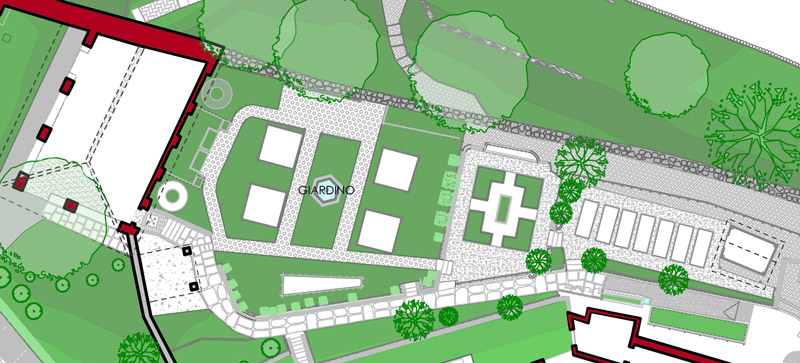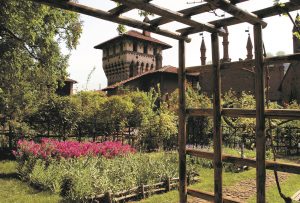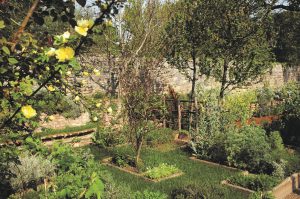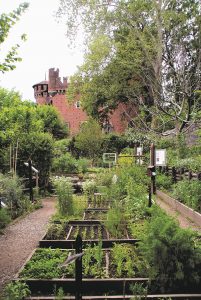Through the siege weapon canopy, visitors enter the Giardino delle delizie (Garden of Delights), rich in flowering plants, the Giardino dei “rimedi semplici” (Garden of “simple remedies”), cultivated with aromatic and medicinal herbs, and the Orto (Kitchen Garden), with a shed for storing tools.
Created between 1997 and 2000, this is a small-scale reproduction of a medieval garden, with its furniture, plants and tools.
Spostati sulla mappa per scoprire i giardini del Borgo

Il giardino delle delizie (Garden of Delights)
Il giardino dei semplici (Hortus simplicium)
L’orto (the kitchen garden)
Il giardino delle delizie (Garden of Delights)

It’s a “secret” garden where the court could spend time in the open air surrounded by a joyful environment, formed by four square flowerbeds bordered by low chestnut branch fences, with a fountain in the centre. Characteristic elements are the espaliers of antique and botanical roses that surround it on two sides, a pergola of vines and roses, a stage with grass-covered seats, and terracotta pots and furniture made of woven willow branches characteristic of the late Middle Ages. Plants typical of the Middle Ages can be found in the flowerbeds: roses, primroses, lilies, violets, irises and daisies.
Il giardino dei semplici (Hortus simplicium)

The Hortus simplicium houses humble plants, once appreciated not for their beauty but for their usefulness. According to tradition, this garden was cared for and frequented by simple people, such as servants, cooks who prepared the dishes, but above all by herbalist monks who found here all the medicinal plants used for their activities. All the plants grown here were therefore used for cooking, as medicines and cosmetics.
Its transformation from a kitchen garden to a pharmacy and a place dedicated to the study of plants led to the creation of the first botanical gardens in Italy (Pisa 1543, Padua and Florence 1545), followed by other study gardens in various European countries.
At the centre of the garden, the pomegranate plant symbolising life, prosperity and abundance is surrounded by beds containing aromatic and medicinal plants such as sage, lemon balm, thyme, marjoram and wormwood, mixed with textile plants such as flax and unusual dyes such as madder and woad, which gave fabrics and textiles unique shades of red and blue.
L’orto (the Kitchen Garden)

It was created to provide an example of the horticultural species cultivated in medieval times. Vegetables, pulses, cereals and aromatic herbs alternate in the small spaces and vary from season to season and from year to year due to frequent rotations. We do not find potatoes, tomatoes and peppers here, as these only arrived in Europe later.
In addition to wild botanical species (rocket, chicory), there are modern varieties of vegetables closer in morphological aspects to their medieval counterparts.
The kitchen garden has a shed made of willow branches and rye straw for storing tools, dried herbs and seeds.
